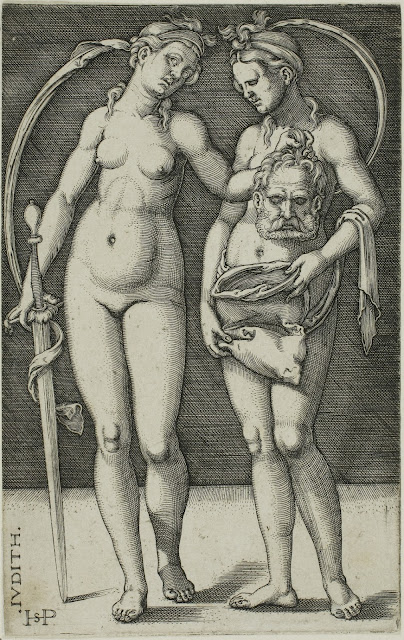 |
| Monogrammist PP Triumph of the Moon ca. 1500-1510 engraving and drypoint Art Institute of Chicago |
"Closer still to [Giulio] Campagnola, and possibly even superior to him in quality, was the mysterious Ferrarese printmaker known only by the initials PP. Just nine prints have been recorded by his hand, all combining engraving with drypoint and stipple work, and all of extraordinary subtlety. This Master PP followed Giulio's experience almost to the letter, and in his best print – the allegory of the Triumph of the Moon, known in three states – it is clear that the artist went from pure line engraving to rich dotted work, exactly as Campagnola had done."
– David Landau and Peter W. Parshall, The Renaissance Print, 1470-1550 (Yale University Press, 1994)
 |
| Albrecht Dürer The Standard Bearer ca. 1500 engraving Art Institute of Chicago |
 |
| Albrecht Dürer Satyr Family 1505 engraving Art Institute of Chicago |
 |
| Benedetto Montagna after Albrecht Dürer The Great Horse ca. 1506-1510 engraving Museum of Fine Arts, Boston |
 |
| Benedetto Montagna Man seated by a Palm Tree ca. 1510-15 engraving National Gallery of Art, Washington DC |
 |
| Benedetto Montagna St George 1506 engraving Art Institute of Chicago |
 |
| Marcantonio after Raphael The Morbetto, or, The Plague of Phrygia (scene from The Aeneid) 1515-16 engraving Art Institute of Chicago |
Raphael's drawing of The Plague in Phrygia, ca. 1512, on which Marcantonio's engraving is based, was itself derived from an episode in Virgil's Aeneid. After the fall of Troy, survivors had relocated and begun to build a new city, "when suddenly the air was poisoned, and a terrible insidious sickness took possession of human bodies, the leaves on the trees, and the seeds in the fields." Raphael and Marcantonio set this literary plague-scene against the ruinous state of Rome's ancient remains, newly valued by Renaissance artists and thinkers, and newly subject to efforts aimed at preservation and restoration. The print implies that both corporal and cultural "sickness" stand in equal need of care.
 |
| Daniel Hopfer Three Turkish Soldiers (Cavalrymen) ca. 1520 etching Art Institute of Chicago |
 |
| Daniel Hopfer Adam ca. 1522 etching Art Institute of Chicago |
 |
| Daniel Hopfer Eve ca. 1522 etching Art Institute of Chicago |
 |
| Heinrich Aldegrever Judith with the Head of Holofernes 1528 engraving Art Institute of Chicago |
 |
| Barthel Beham Judith with the Head of Holofernes 1525 engraving Art Institute of Chicago |
 |
| Sebald Beham Judith with the Head of Holofernes ca. 1520-30 engraving Art Institute of Chicago |
 |
| Sebald Beham Buffoon and Two Bathing Women 1541 engraving Art Institute of Chicago |